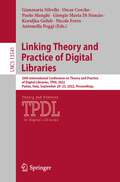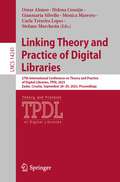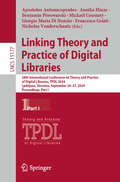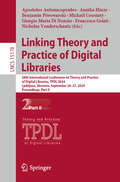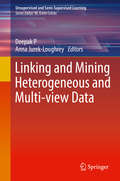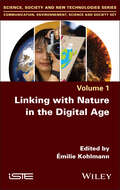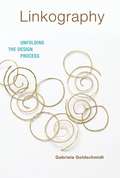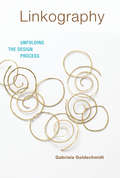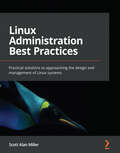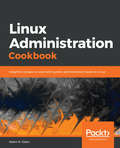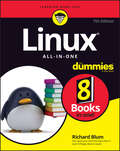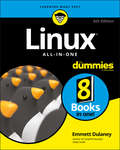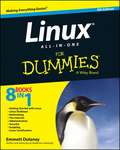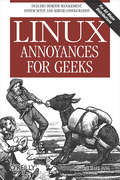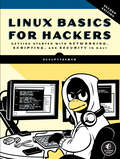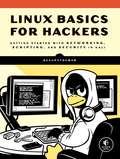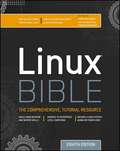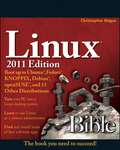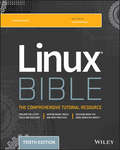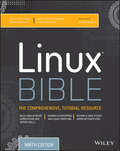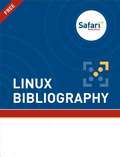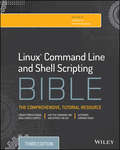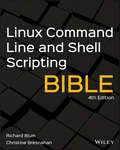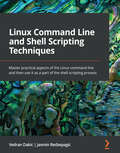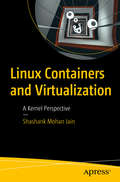- Table View
- List View
Linking Theory and Practice of Digital Libraries: 26th International Conference on Theory and Practice of Digital Libraries, TPDL 2022, Padua, Italy, September 20–23, 2022, Proceedings (Lecture Notes in Computer Science #13541)
by Oscar Corcho Nicola Ferro Paolo Manghi Giorgio Maria Di Nunzio Gianmaria Silvello Antonella Poggi Koraljka GolubThis book constitutes the proceedings of the 26th International Conference on Theory and Practice of Digital Libraries, TPDL 2022, which took place in Padua, Italy, in September 2022. The 18 full papers, 27 short papers and 15 accelerating innovation papers included in these proceedings were carefully reviewed and selected from 107 submissions. They focus on digital libraries and associated technical, practical, and social issues.
Linking Theory and Practice of Digital Libraries: 27th International Conference on Theory and Practice of Digital Libraries, TPDL 2023, Zadar, Croatia, September 26–29, 2023, Proceedings (Lecture Notes in Computer Science #14241)
by Gianmaria Silvello Omar Alonso Helena Cousijn Mónica Marrero Carla Teixeira Lopes Stefano MarchesinThis book constitutes the refereed proceedings of the 27th International Conference on Linking Theory and Practice of Digital Libraries, TPDL 2023, held in Zadar, Croatia, during September 26–29, 2023.The 13 full papers and 17 short papers included in this book were carefully reviewed and selected from 69 submissions. They were organized in topical sections as follows: Applications and digital library systems; data citation and citation analysis; discovering science, monitoring and publishing science; knowledge creation; Human-Computer Interaction; digital humanities; and digital cultural heritage.
Linking Theory and Practice of Digital Libraries: 28th International Conference on Theory and Practice of Digital Libraries, TPDL 2024, Ljubljana, Slovenia, September 24–27, 2024, Proceedings, Part I (Lecture Notes in Computer Science #15177)
by Giorgio Maria Di Nunzio Benjamin Piwowarski Annika Hinze Apostolos Antonacopoulos Mickaël Coustaty Francesco Gelati Nicholas VanderschantzThis book constitutes the refereed proceedings of the 28th International Conference on Linking Theory and Practice of Digital Libraries, TPDL 2024, held in Ljubljana, Slovenia, during September 24–27. The 13 full papers, 19 short papers and 11 papers of other types included in this book were carefully reviewed and selected from 83 submissions. Over the years, TPDL has established itself as an important international forum focused on digital libraries and associated technical, practical, and social issues. In 2024, TPDL expanded its scope to prominently include Document Analysis/Recognition and Information Retrieval, acknowledging the vital role of those research areas in the creation (by means of digitization and information extraction from heterogeneous sources), access, discovery, and dissemination of digital content.
Linking Theory and Practice of Digital Libraries: 28th International Conference on Theory and Practice of Digital Libraries, TPDL 2024, Ljubljana, Slovenia, September 24–27, 2024, Proceedings, Part II (Lecture Notes in Computer Science #15178)
by Giorgio Maria Di Nunzio Benjamin Piwowarski Annika Hinze Apostolos Antonacopoulos Mickaël Coustaty Francesco Gelati Nicholas VanderschantzThis book constitutes the refereed proceedings of the 28th International Conference on Linking Theory and Practice of Digital Libraries, TPDL 2024, held in Ljubljana, Slovenia, during September 24–27. The 13 full papers, 19 short papers and 11 papers of other types included in this book were carefully reviewed and selected from 83 submissions. Over the years, TPDL has established itself as an important international forum focused on digital libraries and associated technical, practical, and social issues. In 2024, TPDL expanded its scope to prominently include Document Analysis/Recognition and Information Retrieval, acknowledging the vital role of those research areas in the creation (by means of digitization and information extraction from heterogeneous sources), access, discovery, and dissemination of digital content.
Linking and Mining Heterogeneous and Multi-view Data (Unsupervised and Semi-Supervised Learning)
by Deepak P Anna Jurek-LoughreyThis book highlights research in linking and mining data from across varied data sources. The authors focus on recent advances in this burgeoning field of multi-source data fusion, with an emphasis on exploratory and unsupervised data analysis, an area of increasing significance with the pace of growth of data vastly outpacing any chance of labeling them manually. The book looks at the underlying algorithms and technologies that facilitate the area within big data analytics, it covers their applications across domains such as smarter transportation, social media, fake news detection and enterprise search among others. This book enables readers to understand a spectrum of advances in this emerging area, and it will hopefully empower them to leverage and develop methods in multi-source data fusion and analytics with applications to a variety of scenarios.Includes advances on unsupervised, semi-supervised and supervised approaches to heterogeneous data linkage and fusion; Covers use cases of analytics over multi-view and heterogeneous data from across a variety of domains such as fake news, smarter transportation and social media, among others;Provides a high-level overview of advances in this emerging field and empowers the reader to explore novel applications and methodologies that would enrich the field.
Linking with Nature in the Digital Age
by Émilie KohlmannThe use of digital technology in our societies is growing to meet the ever-increasing challenges of data collection, raising awareness, education and understanding nature. Artificial intelligence, for example, appears to be the answer to collecting massive amounts of data on biodiversity at a global scale and facilitating citizen participation in such data collection. Linking with Nature in the Digital Age explores the reconfiguration of our relationship with nature within this digital framework. This book examines this mediated linking from three angles. Firstly, it shows how digital technology can foster the development of links to nature. Then, it describes in greater detail the materiality of these links and how they have evolved with the developments in information technology. Finally, it questions the belief in the digital as a facilitator and opens up new perspectives on our relationship with nature and the living world
Linkography
by Gabriela GoldschmidtThis book presents linkography, a method for the notation and analysis of the design process. Developed by Gabriela Goldschmidt in an attempt to clarify designing, linkography documents how designers think, generate ideas, put them to the test, and combine them into something meaningful. With linkography, Goldschmidt shows that there is a logic to the creative process -- that it is not, as is often supposed, pure magic. Linkography draws on design practice, protocol analysis, and insights from cognitive psychology. Goldschmidt argues that the generation of ideas (and their inspection and adjustment) evolves over a large number of small steps, which she terms design moves. These combine in a network of moves, and the patterns of links in the networks manifest a "good fit," or congruence, among the ideas. Goldschmidt explains what parts of the design process can be observed and measured in a linkograph, describing its features and notation conventions. The most significant elements in a linkograph are critical moves, which are particularly rich in links. Goldschmidt presents studies that show the importance of critical moves in design thinking; describes cases that demonstrate linkography's effectiveness in studying the creative process in design (focusing on the good fit); and offers thirteen linkographic studies conducted by other researchers that show the potential of linkography in design thinking research and beyond. Linkography is the first book-length treatment of an approach to design thinking that has already proved influential in the field.
Linkography: Unfolding the Design Process (Design Thinking, Design Theory)
by Gabriela GoldschmidtThe description of a method for the notation and analysis of the creative process in design, drawing on insights from design practice and cognitive psychology.This book presents linkography, a method for the notation and analysis of the design process. Developed by Gabriela Goldschmidt in an attempt to clarify designing, linkography documents how designers think, generate ideas, put them to the test, and combine them into something meaningful. With linkography, Goldschmidt shows that there is a logic to the creative process—that it is not, as is often supposed, pure magic. Linkography draws on design practice, protocol analysis, and insights from cognitive psychology.Goldschmidt argues that the generation of ideas (and their inspection and adjustment) evolves over a large number of small steps, which she terms design moves. These combine in a network of moves, and the patterns of links in the networks manifest a “good fit,” or congruence, among the ideas. Goldschmidt explains what parts of the design process can be observed and measured in a linkograph, describing its features and notation conventions. The most significant elements in a linkograph are critical moves, which are particularly rich in links. Goldschmidt presents studies that show the importance of critical moves in design thinking; describes cases that demonstrate linkography's effectiveness in studying the creative process in design (focusing on the good fit); and offers thirteen linkographic studies conducted by other researchers that show the potential of linkography in design thinking research and beyond. Linkography is the first book-length treatment of an approach to design thinking that has already proved influential in the field.
Linux Administration Best Practices: Practical solutions to approaching the design and management of Linux systems
by Scott Alan MillerGain an understanding of system administration that will remain applicable throughout your career and understand why tasks are done rather than how to do themKey FeaturesDeploy, secure, and maintain your Linux system in the best possible wayDiscover best practices to implement core system administration tasks in LinuxExplore real-world decisions, tasks, and solutions involved in Linux system administrationBook DescriptionLinux is a well-known, open source Unix-family operating system that is the most widely used OS today. Linux looks set for a bright future for decades to come, but system administration is rarely studied beyond learning rote tasks or following vendor guidelines. To truly excel at Linux administration, you need to understand how these systems work and learn to make strategic decisions regarding them. Linux Administration Best Practices helps you to explore best practices for efficiently administering Linux systems and servers. This Linux book covers a wide variety of topics from installation and deployment through to managing permissions, with each topic beginning with an overview of the key concepts followed by practical examples of best practices and solutions. You'll find out how to approach system administration, Linux, and IT in general, put technology into proper business context, and rethink your approach to technical decision making. Finally, the book concludes by helping you to understand best practices for troubleshooting Linux systems and servers that'll enable you to grow in your career as well as in any aspect of IT and business. By the end of this Linux administration book, you'll have gained the knowledge needed to take your Linux administration skills to the next level.What you will learnFind out how to conceptualize the system administrator roleUnderstand the key values of risk assessment in administrationApply technical skills to the IT business contextDiscover best practices for working with Linux specific system technologiesUnderstand the reasoning behind system administration best practicesDevelop out-of-the-box thinking for everything from reboots to backups to triagePrioritize, triage, and plan for disasters and recoveriesDiscover the psychology behind administration dutiesWho this book is forThis book is for anyone looking to fully understand the role and practices of being a professional system administrator, as well as for system engineers, system administrators, and anyone in IT or management who wants to understand the administration career path. The book assumes a basic understanding of Linux, including the command line, and an understanding of how to research individual tasks. Basic working knowledge of Linux systems and servers is expected.
Linux Administration Cookbook: Insightful recipes to work with system administration tasks on Linux
by Adam K. DeanOver 100 recipes to get up and running with the modern Linux administration ecosystem Key Features Understand and implement the core system administration tasks in Linux Discover tools and techniques to troubleshoot your Linux system Maintain a healthy system with good security and backup practices Book Description Linux is one of the most widely used operating systems among system administrators,and even modern application and server development is heavily reliant on the Linux platform. The Linux Administration Cookbook is your go-to guide to get started on your Linux journey. It will help you understand what that strange little server is doing in the corner of your office, what the mysterious virtual machine languishing in Azure is crunching through, what that circuit-board-like thing is doing under your office TV, and why the LEDs on it are blinking rapidly. This book will get you started with administering Linux, giving you the knowledge and tools you need to troubleshoot day-to-day problems, ranging from a Raspberry Pi to a server in Azure, while giving you a good understanding of the fundamentals of how GNU/Linux works. Through the course of the book, you'll install and configure a system, while the author regales you with errors and anecdotes from his vast experience as a data center hardware engineer, systems administrator, and DevOps consultant. By the end of the book, you will have gained practical knowledge of Linux, which will serve as a bedrock for learning Linux administration and aid you in your Linux journey. What you will learn Install and manage a Linux server, both locally and in the cloud Understand how to perform administration across all Linux distros Work through evolving concepts such as IaaS versus PaaS, containers, and automation Explore security and configuration best practices Troubleshoot your system if something goes wrong Discover and mitigate hardware issues, such as faulty memory and failing drives Who this book is for If you are a system engineer or system administrator with basic experience of working with Linux, this book is for you.
Linux All-In-One For Dummies
by Richard BlumLinux is for everyone! Linux All-in-One For Dummies breaks down the ever-popular operating system to its basics and trains users on the art of Linux. This handy reference covers all the latest updates and operating system features. It presents content on Linux desktops, applications, and more. With eight books in one, you&’ll have access to the most comprehensive overview of Linux around. Explore the inner workings of Linux machines, so you&’ll know Linux front to back. This all-inclusive handbook also walks you through solving Linux problems—complete with hands-on examples—so you&’ll be a Linux whiz before you know it. Get familiar with Linux as you install and customize the operating system Learn how to navigate the file system, use the Linux shell, and get online Become a Linux guru with server hosting, scripting, and security how-tos Study for your Linux certification by using this complete guide as your referenceThis book is a massive source of support for beginning and intermediate Linux users, as well as those looking to brush up on their knowledge for certification. And, thanks to the signature Dummies approach, it&’s also a lot of fun.
Linux All-In-One For Dummies: All-in-one Desk Reference For Dummies
by Emmett Dulaney8 mini books chock full of Linux! Inside, over 800 pages of Linux topics are organized into eight task-oriented mini books that help you understand all aspects of the latest OS distributions of the most popular open-source operating system in use today. Topics include getting up and running with basics, desktops, networking, internet services, administration, security, scripting, Linux certification, and more. This new edition of Linux All-in-One For Dummies has a unique focus on Ubuntu, while still including coverage of Debian, Red Hat, SuSE, and others. The market is looking for administrators, and part of the qualifications needed for job openings is the authentication of skills by vendor-neutral third parties (CompTIA/Linux Professional Institute)—and that’s something other books out there don’t address. Install and configure peripherals, software packages, and keep everything current Connect to the internet, set up a local area network (including a primer on TCP/IP, and managing a local area network using configuration tools and files) Browse the web securely and anonymously Get everything you need to pass your entry-level Linux certification exams This book is for anyone getting familiar with the Linux OS, and those looking for test-prep content as they study for the level-1 Linux certification!
Linux All-in-One For Dummies
by Emmett DulaneyA complete guide and reference to five major Linux distributionsLinux continues to grow in popularity worldwide as a low-cost, reliable operating system for enterprise use. Nine minibooks in this guide cover everything administrators need to know about the five leading versions: Ubuntu, Fedora Core, OpenSUSE, Mint, and Mandriva. The companion DVD includes full Ubuntu installations and ISO images for the other four, saving hours of downloading time.The open source Linux operating system is gaining market share around the world for both desktop and server use; this soup-to-nuts guide covers installation and everything else administrators need to know about Ubuntu, Fedora Core, OpenSUSE, Mint, and MandrivaNine self-contained minibooks cover Linux basics, desktops, networking, Internet, administration, security, Linux servers, programming, and scriptingUpdated to cover the newest versions of the five top distributions, with complete installation instructions and a DVD including the full Ubuntu installations and ISO images for the othersLinux users and administrators will be able to install and sample five popular Linux flavors with the information in Linux All-in-One For Dummies.Note: CD-ROM/DVD and other supplementary materials are not included as part of eBook file.
Linux Annoyances for Geeks
by Michael JangGNU/Linux is an immensely popular operating system that is both extremely stable and reliable. But it can also induce minor headaches at the most inopportune times, if you're not fully up to speed with its capabilities. A unique approach to running and administering Linux systems, Linux Annoyances for Geeks addresses the many poorly documented and under-appreciated topics that make the difference between a system you struggle with and a system you really enjoy. This book is for power users and system administrators who want to clear away barriers to using Linux for themselves and for less-trained users in their organizations. This book meticulously tells you how to get a stubborn wireless card to work under Linux, and reveals little-known sources for wireless driversand information. It tells you how to add extra security to your systems, such as boot passwords, and how to use tools such as rescue disks to overcome overly zealous security measures in a pinch. In every area of desktop and server use, the book is chock full of advice based on hard-earned experience. Author Michael Jang has spent many hours trying out software in a wide range of environments and carefully documenting solutions for the most popular Linux distributions. (The book focuses on Red Hat/Fedora, SUSE, and Debian.) Many of the topics presented here are previously undocumented or are discussed only in obscure email archives. One of the valuable features of this book for system administrators and Linux proponents in general is the organization of step-by-step procedures that they can customize for naive end-users at their sites. Jang has taken into account not only the needs of a sophisticated readership, but the needs of other people those readers may serve. Sometimes, a small thing for a user (such as being able to play a CD) or for an administrator (such as updating an organizations' systems from a central server) can make or break the adoption of Linux. This book helps you overcome the most common annoyances in deploying Linux, and trains you in the techniques that will help you overcome other problems you find along the way. In keeping with the spirit of the Annoyances series, the book adopts a sympathetic tone that will quickly win you over. Rather than blaming you for possessing limited Linux savvy, Linux Annoyances for Geeks takes you along for a fun-filled ride as you master the system together.
Linux Basics for Hackers, 2nd Edition: Getting Started with Networking, Scripting, and Security in Kali
by OccupyTheWebA revised introduction to the Linux operating system for beginning hackers and penetration testers.If you&’re just getting started along the exciting path of hacking, cybersecurity, and pentesting, Linux Basics for Hackers is an excellent introduction. With Kali Linux, an operating system designed for digital forensics and penetration testing, you&’ll learn the basics of using Linux and acquire the tools and techniques you&’ll need to take control of a Linux environment.First, you&’ll learn how to install Kali on a virtual machine and get an introduction to basic Linux concepts. Next, you&’ll tackle broader Linux topics like manipulating text, controlling file and directory permissions, and managing user environment variables. You&’ll then focus on foundational hacking concepts like security and anonymity and learn scripting skills with bash and Python. Practical tutorials and exercises throughout will reinforce and test your skills as you learn how to:Cover your tracks by changing your network information and manipulating the journalctl logging utilityWrite a tool to scan for network connections, and connect and listen to wireless networksKeep your internet activity stealthy using Tor, proxy servers, VPNs, and encrypted emailWrite a bash script to find potential attack targets over a range of IP addressesUse and abuse services like MySQL, the Apache web server, and OpenSSHBuild your own hacking tools, such as remote spy cameras and password crackersNew to this edition: This second edition has been updated to address recent changes to Kali and Linux, including a more secure approach to root privileges, updates to Bluetooth and Linux logging functions, and a new chapter with advice on AI in cybersecurity.Hacking is complex, and there is no single way in. Why not start at the beginning with Linux Basics for Hackers?
Linux Basics for Hackers: Getting Started with Networking, Scripting, and Security in Kali
by OccupyTheWebThis practical, tutorial-style book uses the Kali Linux distribution to teach Linux basics with a focus on how hackers would use them. Topics include Linux command line basics, filesystems, networking, BASH basics, package management, logging, and the Linux kernel and drivers.If you're getting started along the exciting path of hacking, cybersecurity, and pentesting, Linux Basics for Hackers is an excellent first step. Using Kali Linux, an advanced penetration testing distribution of Linux, you'll learn the basics of using the Linux operating system and acquire the tools and techniques you'll need to take control of a Linux environment.First, you'll learn how to install Kali on a virtual machine and get an introduction to basic Linux concepts. Next, you'll tackle broader Linux topics like manipulating text, controlling file and directory permissions, and managing user environment variables. You'll then focus in on foundational hacking concepts like security and anonymity and learn scripting skills with bash and Python. Practical tutorials and exercises throughout will reinforce and test your skills as you learn how to: - Cover your tracks by changing your network information and manipulating the rsyslog logging utility - Write a tool to scan for network connections, and connect and listen to wireless networks - Keep your internet activity stealthy using Tor, proxy servers, VPNs, and encrypted email - Write a bash script to scan open ports for potential targets - Use and abuse services like MySQL, Apache web server, and OpenSSH - Build your own hacking tools, such as a remote video spy camera and a password crackerHacking is complex, and there is no single way in. Why not start at the beginning with Linux Basics for Hackers?
Linux Bible
by Christopher Negus Christine BresnahanMore than 50 percent new and revised content for today's Linux environment gets you up and running in no time!Linux continues to be an excellent, low-cost alternative to expensive operating systems. Whether you're new to Linux or need a reliable update and reference, this is an excellent resource. Veteran bestselling author Christopher Negus provides a complete tutorial packed with major updates, revisions, and hands-on exercises so that you can confidently start using Linux today.Offers a complete restructure, complete with exercises, to make the book a better learning toolPlaces a strong focus on the Linux command line tools and can be used with all distributions and versions of LinuxFeatures in-depth coverage of the tools that a power user and a Linux administrator need to get startedThis practical learning tool is ideal for anyone eager to set up a new Linux desktop system at home or curious to learn how to manage Linux server systems at work.
Linux Bible 2010 Edition
by Christopher NegusThe definitive guide to the basics of one of the most popular operating systems in the worldWhether you're a first-time Linux user or you're migrating from another operating system, this book is an ideal introductory guide for getting comfortable with the building-block nature of Linux. Written by bestselling author Christopher Negus, this guide is packed with in-depth descriptions on the basics of Linux desktops, servers, and programming tools and gets you up to speed on all the new and exciting features of the newest version: Linux 2010. Negus walks you through transitioning from Windows or Mac and helps you find the Linux distribution that best meets your needs.You'll explore more than 18 Linux distributions, including the latest versions of Ubuntu, Fedora, Debian, OpenSUSE, Slackware, Knoppix, Gentoo, Mandriva, SLAX, and more. Plus, you'll discover how to set up secure, fully functioning Linux server systems and get up-to-date installation advice.Topics Covered:Getting off the Ground with LinuxRunning a Linux DesktopLearning System Administration SkillsSetting Up Linux ServersChoosing and Installing Different Linux DistributionsProgramming in LinuxLinux Bible 2010 Edition walks you through the details of the various Linux distributions and updates you on the latest networking, desktop, and server enhancements.Note: CD-ROM/DVD and other supplementary materials are not included as part of eBook file.
Linux Bible: Boot Up Ubuntu, Fedora, Knoppix, Debian, Suse, And 11 Other Distributions (Bible #490)
by Christopher NegusThe industry favorite Linux guide Linux Bible, 10th Edition is the ultimate hands-on Linux user guide, whether you're a true beginner or a more advanced user navigating recent changes. this updated tenth edition covers the latest versions of Red Hat Enterprise Linux (RHEL 8), Fedora 30, and Ubuntu 18.04 LTS. It includes information on cloud computing, with new guidance on containerization, Ansible automation, and Kubernetes and OpenShift. With a focus on RHEL 8, this new edition teaches techniques for managing storage, users, and security, while emphasizing simplified administrative techniques with Cockpit. Written by a Red Hat expert, this book provides the clear explanations and step-by-step instructions that demystify Linux and bring the new features seamlessly into your workflow. This useful guide assumes a base of little or no Linux knowledge, and takes you step by step through what you need to know to get the job done. Get Linux up and running quickly Master basic operations and tackle more advanced tasks Get up to date on the recent changes to Linux server system management Bring Linux to the cloud using Openstack and Cloudforms Simplified Linux administration through the Cockpit Web Interface Automated Linux Deployment with Ansible Learn to navigate Linux with Amazon (AWS), Google (GCE), and Microsofr Azure Cloud services Linux Bible, 10th Edition is the one resource you need, and provides the hands-on training that gets you on track in a flash.
Linux Bible: Boot Up Ubuntu, Fedora, Knoppix, Debian, Suse, And 11 Other Distributions (Bible #772)
by Christopher NegusThe industry favorite Linux guide, updated for Red Hat Enterprise Linux 7 and the cloud Linux Bible, 9th Edition is the ultimate hands-on Linux user guide, whether you're a true beginner or a more advanced user navigating recent changes. This updated ninth edition covers the latest versions of Red Hat Enterprise Linux 7 (RHEL 7), Fedora 21, and Ubuntu 10.04 LTS, and includes new information on cloud computing and development with guidance on Openstack and Cloudforms. With a focus on RHEL 7, this practical guide gets you up to speed quickly on the new enhancements for enterprise-quality file systems, the new boot process and services management, firewalld, and the GNOME 3 desktop. Written by a Red Hat expert, this book provides the clear explanations and step-by-step instructions that demystify Linux and bring the new features seamlessly into your workflow. This useful guide assumes a base of little or no Linux knowledge, and takes you step by step through what you need to know to get the job done. Get Linux up and running quickly Master basic operations and tackle more advanced tasks Get up to date on the recent changes to Linux server system management Bring Linux to the cloud using Openstack and Cloudforms Linux Bible, 9th Edition is the one resource you need, and provides the hands-on training that gets you on track in a flash.
Linux Bibliography
by Safari Content TeamLinux powers the servers and machines that power a significant proportion of the Internet, and it forms the backbone of a variety of different modern operating systems, particularly in the embedded and smaller systems markets, such as ARM-based desktops, laptops and set top systems. In fact, Linux is now the solution behind so many different things: from game consoles, to media platforms, to massive database servers, to clusters, and to some of the most powerful computing clusters in the world. Linux manages to span the full gamut of hardware platforms from watches to supercomputers. In this bibliography we have collected a range of different titles that cover the basics of installing your Linux system, how to use it and deploy it, and how to make use of the different systems. We've also collected guides to specific environments and distributions, including Fedora, SUSE, Ubuntu and the Raspberry Pi platform. For more generic content, there are titles on kernel development, device driver building and the Linux programming interfaces. Maybe programming Linux is more appealing to you, in which case you can find books on everything from system programming to C++, Perl, Python and more with a focus on the Linux or Linux-like environment. For administration and deployment, you'll want to examine the books that cover the core of administration, shell tools, and the specific guides on security, Oracle and development stack solutions such as LAMP (Linux, Apache, MySQL, and Perl/Python/PHP). Finally, if you want to develop your professional skills and get certified, or just learn the finer details of the internals, then Safari Books Online has everything you need here and more.
Linux Command Line and Shell Scripting Bible
by Richard Blum Christine BresnahanThe authoritative guide to Linux command line and shell scripting?completely updated and revised [it's not a guide to Linux as a whole ? just to scripting]The Linux command line allows you to type specific Linux commands directly to the system so that you can easily manipulate files and query system resources, thereby permitting you to automate commonly used functions and even schedule those programs to run automatically. This new edition is packed with new and revised content, reflecting the many changes to new Linux versions, including coverage of alternative shells to the default bash shell. For this edition, the author has teamed up with another Linux expert ? with their shared expertise, they take you beyond the basics of shell scripting and guide you through using shell scripting for higher-level applications that are commonly found in Linux environments. In addition, this edition features a host of real-world examples, so you can see how the scripts work in application.Reflects changes to new Linux versions and covers alternate shells to the default bash shellOffers new chapters on working with file system commands and software installation commandsIncludes a plethora of real-world examples of advanced shell scripting Shows how to use shell scripts in a graphical desktop environment With Linux Command Line and Shell Scripting Bible you'll learn to manage file systems, install software, write scripts for graphical desktops, work with alternative shells, and more.
Linux Command Line and Shell Scripting Bible (Bible)
by Richard Blum Christine BresnahanAdvance your understanding of the Linux command line with this invaluable resource Linux Command Line and Shell Scripting Bible, 4th Edition is the newest installment in the indispensable series known to Linux developers all over the world. Packed with concrete strategies and practical tips, the latest edition includes brand-new content covering: Understanding the Shell Writing Simple Script Utilities Producing Database, Web & Email Scripts Creating Fun Little Shell Scripts Written by accomplished Linux professionals Christine Bresnahan and Richard Blum, Linux Command Line and Shell Scripting Bible, 4th Edition teaches readers the fundamentals and advanced topics necessary for a comprehensive understanding of shell scripting in Linux. The book is filled with real-world examples and usable scripts, helping readers navigate the challenging Linux environment with ease and convenience. The book is perfect for anyone who uses Linux at home or in the office and will quickly find a place on every Linux enthusiast’s bookshelf.
Linux Command Line and Shell Scripting Techniques: Master practical aspects of the Linux command line and then use it as a part of the shell scripting process
by Vedran Dakic Jasmin RedzepagicPractical and actionable recipes for using shell and command-line scripting on your Linux OS with confidenceKey FeaturesLearn how to use the command line and write and debug Linux Shell scriptsAutomate complex repetitive tasks and backups, and learn networking and securityA practical approach to system administration, and virtual machine and software managementBook DescriptionLinux Command Line and Shell Scripting Techniques begins by taking you through the basics of the shell and command-line utilities. You'll start by exploring shell commands for file, directory, service, package, and process management. Next, you'll learn about networking - network, firewall and DNS client configuration, ssh, scp, rsync, and vsftpd, as well as some network troubleshooting tools.You'll also focus on using the command line to find and manipulate text content, via commands such as cut, egrep, and sed. As you progress, you'll learn how to use shell scripting. You'll understand the basics - input and output, along with various programming concepts such as loops, variables, arguments, functions, and arrays. Later, you'll learn about shell script interaction and troubleshooting, before covering a wide range of examples of complete shell scripts, varying from network and firewall configuration, through to backup and concepts for creating live environments. This includes examples of performing scripted virtual machine installation and administration, LAMP (Linux, Apache, MySQL, PHP) stack provisioning and bulk user creation for testing environments. By the end of this Linux book, you'll have gained the knowledge and confidence you need to use shell and command-line scripts.What you will learnGet an introduction to the command line, text editors, and shell scriptingFocus on regular expressions, file handling, and automating complex tasksAutomate common administrative tasksBecome well-versed with networking and system security scriptingGet to grips with repository management and network-based file synchronizationUse loops, arguments, functions, and arrays for task automationWho this book is forThis book is for anyone looking to learn about Linux administration via CLI and scripting. Those with no Linux command-line interface (CLI) experience will benefit from it by learning from scratch. More experienced Linux administrators or engineers will also find this book useful, as it will help them organize their knowledge, fill in any gaps, and work efficiently with shell scripts to increase productivity.
Linux Containers and Virtualization: A Kernel Perspective
by Shashank Mohan JainGet a novel perspective on Linux containers and understand the world of virtualization. This book takes you down the rabbit hole to discover what lies below the API. You’ll go on a journey of virtualization and see how containers are realized in the Linux world. Linux Containers and Virtualization details the data structures within the Linux kernel which make up Linux containers. You will start with the fundamentals of virtualization including how different resources such as memory, CPU, network, and storage are virtualized. Then you will move on to hypervisors and virtualization using the Kernel virtual Machine (KVM) and Quick Emulator (QEMU). Next, you will learn about Linux namespace, cgroups, and layered file systems, which are the essential building blocks of Linux containers. The explanation traverses the Linux kernel codebase to show how these are realized in the Linux kernel. In the final chapter, you will code your own container by applying the concepts learnt in the previous chapters. On completion of the book, you will have the knowledge to start coding a Linux container. What You Will Learn Understand the basics of virtualizationDiscover how the Linux kernel supports virtualization See how the evolution of the Linux kernel and CPUs led to the creation of containerization technologiesDevelop the ability to create your own container framework Who This Book Is For Developers working on virtualized software deployment and containers. Architects designing platforms based on a container runtime as well as DevOps professionals who want to get a microscopic view on how containers and virtualization work would find the book useful.
